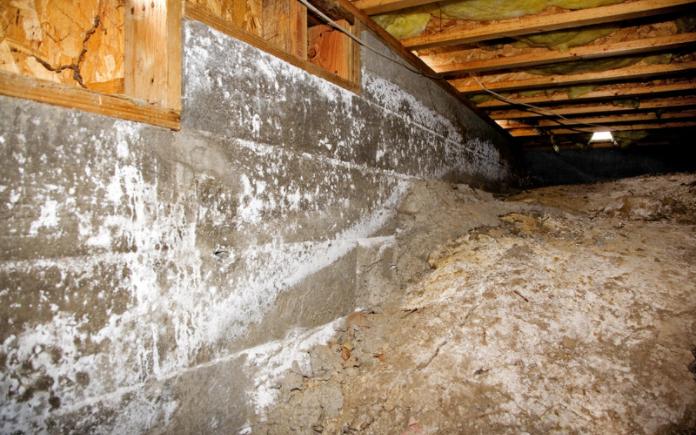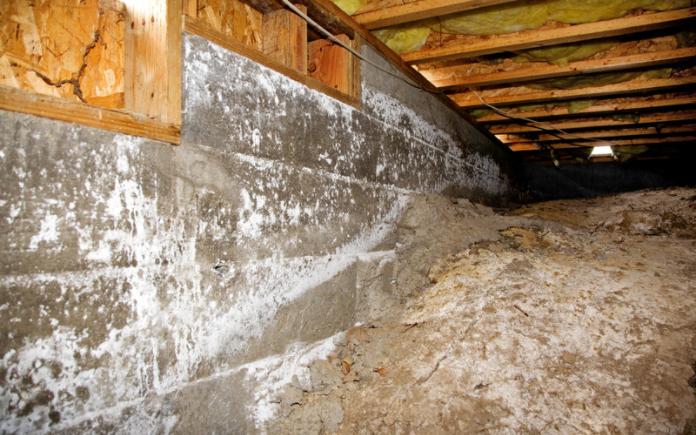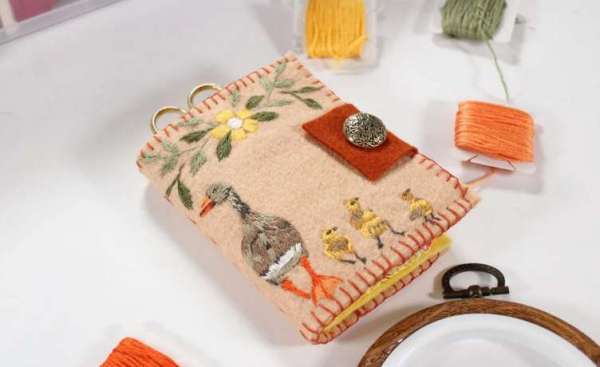
Crawl space moisture control is a constant worry for people living in high-humidity areas.
Moisture in your crawl space can lead to bigger home problems, like warped floorboards and mold, so it’s important to keep it under control.

Check for Drainage Issues
Sometimes natural groundwater migrates up into your home, and other times there’s a drainage issue you might not be aware of that could be contributing to your crawl space moisture.
Flowerbeds and other landscaping can end up damming rainwater and routing it under the house. Next time it’s raining, put on your rain gear and look around to see where that water is going when it comes off the roof or through your downspouts on your gutters.
Encourage the water to move away from the house by redirecting your downspouts.

Lay Down Plastic
If you don’t notice any drainage issues, the moisture could be coming from your heating and cooling unit. When your air conditioner or heat is running, it can pull moisture into cracks and crevices.
The most effective and least expensive way to control moisture in your crawl space is to lay down a piece of plastic right on the ground. A 6-mil plastic sheet will provide an adequate moisture barrier in your crawlspace.
Anchor the plastic sheet with gravel, rocks or bricks to prevent it from blowing if your crawlspace is open. This will keep ground moisture from migrating up into the house.

Open Up the Airflow
The more air you can get under your crawl space, the moisture control you will have. Be sure to keep any bushes and grass near your crawlspace well-trimmed so they don’t block the airflow. You can also try installing an electric foundation vent to blow air out.
If your crawlspace is closed and you have foundation vents, those should stay open all the time to allow the breeze to blow through.
Skip to [7:19] for the full segment on the Today’s Homeowner Podcast.
Also on this episode:
- Swapping a Tub and Shower Locations
- Soil Combinations for Flower Gardens
- Dealing with Condensation in a Tiny Home
- Reducing Dust When Sawing Concrete
Best New Product
 |
The O-Cedar Easywring Rinse Clean Microfiber Spin Mop ensures no shortage of clean water. Learn more>> |
Simple Solutions
Filing System for Owner’s Manual — Here’s a quick, efficient way to organize owner’s manuals for all your tools. Rather than storing all the manuals in one box or drawer, place each one in a zip-lock plastic bag. Then, clip together the individual bags with a binder clip and hang them a nail above your workbench. You can even organize each group of bags into separate categories, such as portable power tools, hand tools and accessories, stationary machinery, and lawn and garden tools. The bags keep the manuals clean and you can easily see through the bags to find the manual you’re looking for.
Fast Furniture Assembly — Assembling kit furniture often requires the use of a hex-key wrench, also known as an Allen wrench, which is painfully slow. Here’s how to speed up the process: Secure the hex-key wrench in a vise and cut off the shorter end of the wrench with a hacksaw or grinder. Then, chuck the long straight section into a cordless drill. Adjust the drill’s torque setting to the lowest number, and drive in the fasteners in mere seconds.
Question of the Week
Q: We just bought a 1,200-square-foot condo that was built in 2010. It has popcorn ceilings throughout, which are in perfectly good shape. I don’t really mind the popcorn, but my wife hates it. Can I remove the popcorn myself or should I hire a contractor?
A: To remove a popcorn ceiling, spray the ceiling with a mix of fabric softener and hot water in a pump-up sprayer. Once it’s softened, you can use a Homax Ceiling Texture Scraper to remove the popcorn. Be sure to lay down plastic drop cloths to collect the popcorn chunks. You can also clip on a garbage bag on the scraper to collect the popcorn as you’re scraping. Let it dry and fix any divots with joint compound before you prime and paint the ceiling. Other alternatives to scraping are covering the popcorn ceiling with drywall or a surface mount.
(Note: Any popcorn ceiling installed before 1970 might contain asbestos, so purchase an asbestos test kit to see if it contains asbestos.)
Other Products and Links Mentioned
This page contains affiliate links. If you purchase a product from these links, we will earn a small commission at no additional cost to you.
Further Reading
Ask a Question! (Podcast)
Ask a question and we could answer it on the “Today’s Homeowner Podcast!” We also may use it on our nationally syndicated radio broadcast or on todayshomeowner.com.











